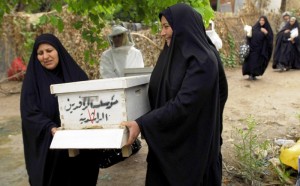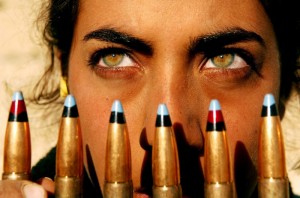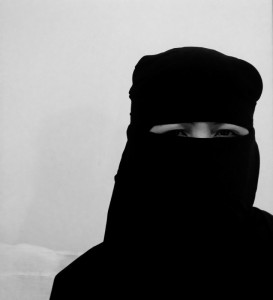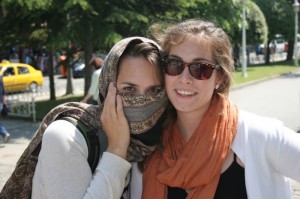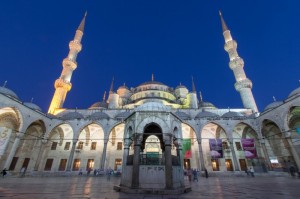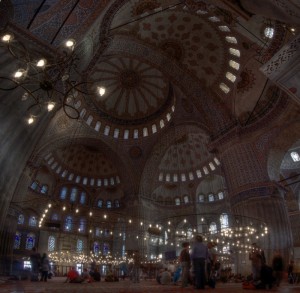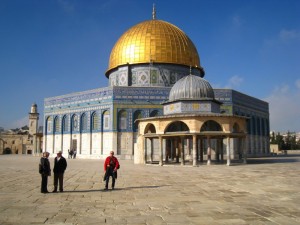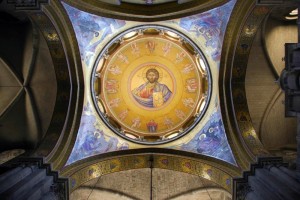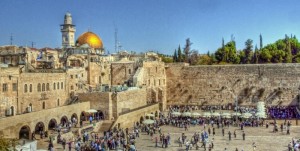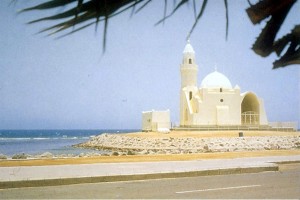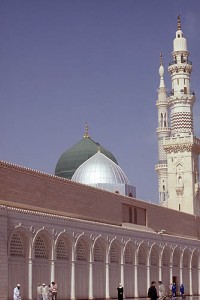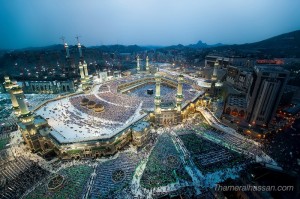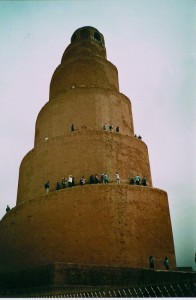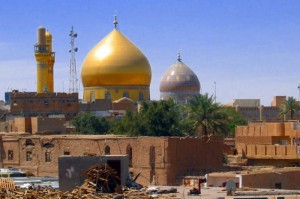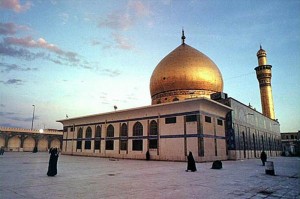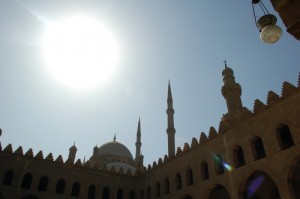Islam in Western Asia
Introduction
When many people think of Islamic nations, the first ones to come to mind are located in the Middle East (Western Asia). Here, we examine five different nations in Western Asia, ranging from those that are very strongly Islamic to those where Islam is a minority religion. We will be examining three aspects of culture in these five societies: women’s status, holidays/celebrations, and architecture to illustrate any similarities or differences between them. The five nations described here are Egypt, Iraq, Israel, Saudi Arabia, and Turkey.
Women’s Status
by Lindsay Timmons
The “Hijab” is a very important concept regarding Muslim women’s rights. The word Hijab comes from an Arabic word meaning “to hide,” and is a form of dress worn by many women in Islam. It comes in many different varieties, ranging from a headscarf to a full facial covering. In general, Muslim women are to dress very modestly, and these head coverings are seen as one method of achieving this (Why the Hijab).
Hijab World
Map of Hijab usage in Western Asia, Africa, and Europe: Red dots denote restrictions, yellow denotes common use, light green denotes very common use, medium green denotes prevalent use, and dark green denotes mandatory usage.
Egypt is listed as light green with a red dot (common use w/ legal restrictions).
Iraq is listed as light green (common use).
Israel is not colored because Islam is a minority religion there.
Saudi Arabia is listed as dark green (mandatory use).
Turkey is listed as light green with a red dot (common use w/ legal restrictions).
The Hijab is also a source of controversy when it comes to women’s rights, as women in some nations are forced under penalty of the law to cover up. In other nations, women are restricted from wearing these coverings in some public places (Why the Hijab).
Egypt
Egypt is a predominantly Muslim nation, and many women there choose to wear the Hijab. Unfortunately, women are not always treated well in Egypt. There are many problems such as sexual assault and violence against women in Egypt today. However, the Hijab is not mandatory for women living there (No Author, 2013).
Egyptian women holding plastic barrels
by Nasser Nouri, used under 
A woman protests the unfair treatment of women by cutting her hair in a public square.
Egyptian Women Cut their Hair in Tahrir Square to Protest Fundamentalist Constitution
by Moud Barthez, used under 
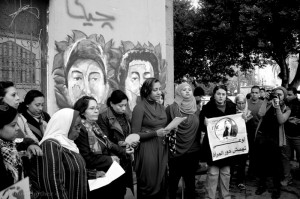 A large group of women protests the unfair treatment of women in Egypt.
A large group of women protests the unfair treatment of women in Egypt.
Women reading a statement anti-new constitution
by Moud Barthez, used under 
Iraq
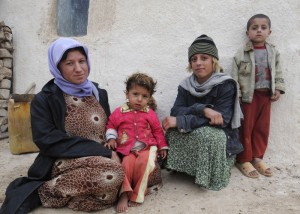 Iraq is another majorly Muslim nation. Legally, women there have far more rights than the women in surrounding countries. They are involved in politics and the workforce. However, these legal guidelines are not always followed, leading to the persecution of women in Iraq (Salbi, 2013).
Iraq is another majorly Muslim nation. Legally, women there have far more rights than the women in surrounding countries. They are involved in politics and the workforce. However, these legal guidelines are not always followed, leading to the persecution of women in Iraq (Salbi, 2013).
Iraqi Family
by DVIDSHUB, used under 
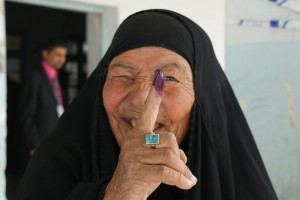 Many women in Iraq are proud voters. Here, an elderly woman displays her mark of voting, a purple stained finger (to ensure no double votes are cast).
Many women in Iraq are proud voters. Here, an elderly woman displays her mark of voting, a purple stained finger (to ensure no double votes are cast).
Proud Iraqi Women Vote in Nasiriyah
by DVIDSHUB, used under 
As these pictures show, the Hijab is very commonly worn in Iraq, by women in many generations. Here, two younger women work as beekeepers.
Iraqi Beekeepers
by JBLM PAO, used under 
Israel
Israel is predominantly Jewish, but its second most popular religion is Islam. Women’s rights in Israel are very advanced, and women are extremely involved in things such as the government, military, and workforce. Fortunately, these rights also extend to the Muslim women living in Israel (Avraham, R).
Israeli woman solider
by Israel Defense Forces, used under 
Saudi Arabia
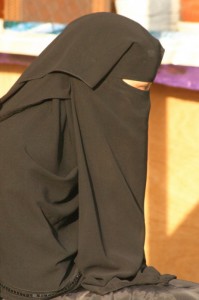 Saudi Arabia is one of the harshest environments for women. They currently cannot vote or drive, and are forced to be accompanied by a male relative while in public. The Hijab is mandatory for all women, because modest is extremely important in Saudi Arabian society. Currently, many women are trying to rise against the oppressive conditions for women in Saudi Arabia (Dewey, 2013).
Saudi Arabia is one of the harshest environments for women. They currently cannot vote or drive, and are forced to be accompanied by a male relative while in public. The Hijab is mandatory for all women, because modest is extremely important in Saudi Arabian society. Currently, many women are trying to rise against the oppressive conditions for women in Saudi Arabia (Dewey, 2013).
Saudi Arabia Abha Souq
by Retlaw Snellac Photography, used under 
As depicted in these images, Saudi Arabian women are forced to wear very restrictive garments that cover their faces.
Saudi Portrait
by Edward Musiak, used under 
Turkey
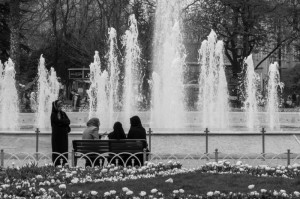 Though Turkey is majorly Islamic, it is technically a secular state. There are many laws regarding the Hijab as well. Many women in Turkey choose to wear a head covering, but are banned in doing so in certain public places. Currently, Turkish women are fighting for gender equality in Turkey (Dorsey, 2013).
Though Turkey is majorly Islamic, it is technically a secular state. There are many laws regarding the Hijab as well. Many women in Turkey choose to wear a head covering, but are banned in doing so in certain public places. Currently, Turkish women are fighting for gender equality in Turkey (Dorsey, 2013).
Muslim Women Relaxing
by Alex Berger, used under 
Some women choose to wear a head covering while others do not.
Turkish Women
by Robert Oxford, used under 
Muslim woman in Turkey.
Headscarf Heaven in Eyupbr by Charles Roffey, used under 
As these pictures and descriptions show, not all Western Asian (or Middle Eastern) countries are on the same page when it comes to women’s rights. From an outsider’s point of view, it may be tempting to group them into one category because of their common religion, but it is important to realize that many legal differences exist. Life for a Muslim woman in one nation may be very different than it is for a Muslim woman in another nation.
Islamic Holidays
By: Ellie Hughes
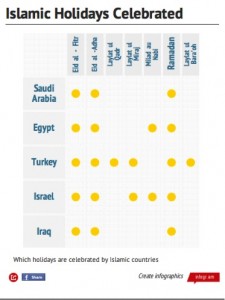
Many of the Islamic holidays have different spellings or names in different countries, so we will use the most common spellings. Each of the holidays falls on a different day each year, based on the lunar calendar.
When the lunar calendar is followed, there is about a 10-day change in the date of the holiday each year (All About Turkey). Although each of these holidays is important to Muslims universally, they are not celebrated as official holidays in every country.
Ramadan is celebrated during the ninth month of the lunar calendar (Asfory). The entire month is a time of fasting, charity, and self-exploration. The fasting takes place during the day and prayers occur at night.

Eid-al-Fitr is the day that the Ramadan fast is broken. It is a day of alms, prayer, feasts, and presents surrounded by family and neighbors. Eid Mubarak is the official greeting during both of the eid celebrations.
EidMubarak
by Drakoheart, used under 
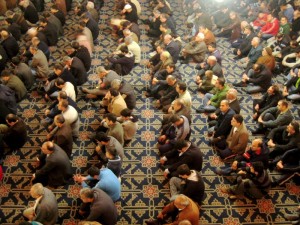
Eid Prayer in Turkey
by Travlr, used under 
Eid-al-Adha is also known as the Feast of Sacrifice and commemorates the sacrifice made by Abraham. The family often eats the food that results from the sacrifice, but most of the meat must be given to the poor. It is similar to the Eid-al-Fitr in how it is celebrated, including once again feasts, prayer, gifts, and time with family and neighbors. (Need to Know).
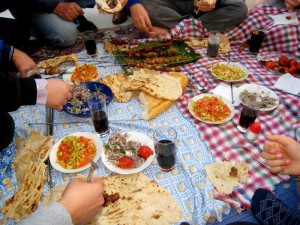
Example of Eid Meal
by Travlr, used under 
Laylatul Qadr is remembered as the night that the Qur’an was revealed to Muhammad. It is a day of special prayer for Muslims and occurs during Ramadan.
Laylatul Bara’ah is the night on which God accounts for the actions of mankind for the year and plans the births and deaths for the year.

Ramadan Prayer
by Mohammad Khedmati, used under 
Laylatul Mi’raj is known as the Night of Ascension of Muhammad. The night is celebrated through extra prayer and special readings of the Qur’an.
Maulidun Nabi is the celebration of the birthday of Muhammad. It is a controversial holiday in some Islamic countries because they believe it pays too much attention to Muhammad. It is a day of celebration comparable to Christmas. (All About Turkey).
Islamic Architecture
By Jun Kang
Unlike Western architecture, Islamic architecture possesses religious styles from the beginning of Islam to the present day. The most common Islamic architectural types are the dome shape known as the Mosque with pillars around the Mosque. Repeating themes of buildings and tiles are commonly interpreted as the concept of God or Allah’s infinite power.
Turkey
 Hagia Sophia, Istanbul, Turkey
Hagia Sophia, Istanbul, Turkey
by David Spender, used under 
This is one of the famous sites in Istanbul, Turkey, and it is currently used as a museum. Formerly, it was patriarchal basilica and was later used as a mosque. Hagia Sophia used to be the largest cathedral in the world for a thousand years. It is well known for the massive domes and the four pillars around the dome shows the Islamic features. The four minarets outside were added due to Islamic influence over the time.
Sultan Ahmed Mosque, Istanbul, Turkey
by Herve BRY, used under 
The building was built between 1609 and 1616, during the rule of Ahmed I. It is also called Blue Mosque because of blue tiles adorning the walls of interior.
Inside of Sultan Ahmed Mosque, Istanbul, Turkey
Sultan Ahmed Mosque, Istanbul, Turkey
by Herve BRY, used under 
Israel
The Dome of the Rock, Jerusalem, Israel
by Francisco Martins, used under 
The Dome of the Rock was the first work of Islamic architecture, and the dome signifies religious traditions regarding the rock, the foundation stone, which emphasizes for Christians, Muslims, and Jews. The dome was built between 685 and 691 and is Islam’s third most holiest place after Mecca and Medina. The dome is located at the Temple Mount site.
The Center of the World, Church of the Holy Sepulchre, Jerusalem, Israel
by Werner Kunz, used under 
The Wailing Wall and The Temple Mount
by Neil Howard, used under 
The Wailing Wall, which is also referred as the Western Wall, is located in the old city of Jerusalem by the western side of the temple mount. The purpose of this wall was to protect Jewish temples from outsiders, and it is considered the most sacred area recognized by the Jewish faith. The wall is believed to be constructed around 19 Before Common Era (BCE).
The Temple Mount is known for one of the most religious area in the old city of Jerusalem.
Saudi Arabia
The Corniche Mosque, Jedda, Saudi Arabia
by MIT OpenCourseWare, used under 
The Corniche Mosque is one of three pavilions that is facing the red sea, and it represents the presence of Islam. An interesting fact about this mosque is that it is built in ways that reflects present and the luminous past of Islamic societies.
Masjid Nabvi, Medina, Saudi Arabia
by rzafar, used under 
Masjid Nabvi, “Mosque of the Prophet,” is a mosque that Islamic Prophet Muhammad built. It is one of the largest mosque in the world and considered as the second holiest place in Islamic world.
The Kaaba in Al-Masjid Al-Haram
by Omar A., used under 
The Kaaba is cubical shaped building in middle of Mecca, Saudi Arabia and is considered as the most sacred place in Islam world. Kaaba is significant because all Muslims around the world face the location of Kaaba during prayers disregard of their locations.
The Holy Grand Mosque in Makkah – Heart of Islam
by Thamer Al-Hassan, used under 
Al-Masjid Al-Haram is the largest mosque in the world that is located in the city of Mecca, Saudi Arabia. In the center of Al-Haram, Kaaba is located where all Muslims face when they perform formal worship. Al-Masjid Al-Haram is known as the holiest place in Islamic world.
Iraq
Al-Malawiyya (Iraq, Samarra, abril 2002)
by Gladys Martinez Lopez, used under 
Malwiya, known as the Minaret of Samarra, is part of the great mosque of Samarra in Iraq. The tower and the mosque was originally connected and it is different to other minarets because it has the spiral conical shape. The word Malwiya translates as twisted. Due to the shape of the tower, Malwiya was not really used for the purpose of praying but more of visually representing the presence of Islam world.
Al Askari Mosque, Samarra, Iraq
by James Gordon, used under 
The Great Mosque of Kufa, Iraq
by James Gordon, used under 
Masjid al-Kufa is one of the early mosques that were built in the world.
Egypt
The Sultan al-Nasir Muhammad ibn Qala’un Mosque
by Gason Rathnow, used under 
Al Nasir Muhammad Mosque was built by the Mamluk Sultan Al-Nasir Muhammad in 1318. It is considered as the royal mosque of the Citadel in Cairo, Egypt. The sultans of Cairo performed their Friday Prayers here.
Masjid Al-Noor
by Firoze Edassery, used under 
This architectural style is Islamic and main usage of the building is mosque.
Published December, 2013.



